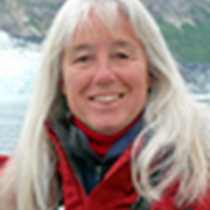Pavlof Harbor, Chichagof Island / Chatham Strait
It is the final day of August and the last voyage in Southeast Alaska before the Sea Bird starts its migration southward down the coast. The season is winding down for everyone here. All organisms have a strategy that allows them to adjust to changes in the time of year. If the changes cannot be endured or resisted locally, they must be avoided altogether.
At Pavlof Harbor this morning, we watched a mother bear with two cubs preparing for a time when food will not be available. They were gorging on sedges and the last of the pink salmon that were gathering at the base of Pavlof Falls in hopes of making it upstream to spawn. The cubs will den-up with their mother this fall and spend the winter in a state of reduced metabolism. Successful sockeye salmon fry will make it through the winter in Pavlof Lake.
Above the falls, an American dipper was perched on a low branch. This interesting bird, both aquatic and terrestrial, feeds underwater on insects. With a large number of insulative and downy feathers, they are able to overwinter along a stretch of stream that remains unfrozen. Other birds that spend the summer in Alaska must migrate to warmer climes for a continuous supply of food.
In the forest we heard the chatter of red squirrels, which are busy stocking up for the winter. They remain active throughout the year but must store food for the time when it will be unavailable.
Near Pavlof Lake there was evidence of beaver activity – a lodge, and teeth marks on tree trunks. The beavers will not hibernate or migrate but must gather food to prepare for and survive the winter.
Even the lowly banana slug, unable to migrate, can crawl into holes or under mosses to keep its invertebrate body from getting too cold.
Continuing our voyage northward we came upon some humpback whales. We stopped to observe them as they came quite close to the ship and demonstrated many behaviors, including spectacular breaches. Soon they will stop feeding in these nutrient-rich waters and start their long migration to Hawaii, where they will have other things on their mind.
Driven by internal clocks and changes in temperature, food, photoperiod, and hormones, the amazing cycles of life and survival continue, day to day, season to season, year to year…
It is the final day of August and the last voyage in Southeast Alaska before the Sea Bird starts its migration southward down the coast. The season is winding down for everyone here. All organisms have a strategy that allows them to adjust to changes in the time of year. If the changes cannot be endured or resisted locally, they must be avoided altogether.
At Pavlof Harbor this morning, we watched a mother bear with two cubs preparing for a time when food will not be available. They were gorging on sedges and the last of the pink salmon that were gathering at the base of Pavlof Falls in hopes of making it upstream to spawn. The cubs will den-up with their mother this fall and spend the winter in a state of reduced metabolism. Successful sockeye salmon fry will make it through the winter in Pavlof Lake.
Above the falls, an American dipper was perched on a low branch. This interesting bird, both aquatic and terrestrial, feeds underwater on insects. With a large number of insulative and downy feathers, they are able to overwinter along a stretch of stream that remains unfrozen. Other birds that spend the summer in Alaska must migrate to warmer climes for a continuous supply of food.
In the forest we heard the chatter of red squirrels, which are busy stocking up for the winter. They remain active throughout the year but must store food for the time when it will be unavailable.
Near Pavlof Lake there was evidence of beaver activity – a lodge, and teeth marks on tree trunks. The beavers will not hibernate or migrate but must gather food to prepare for and survive the winter.
Even the lowly banana slug, unable to migrate, can crawl into holes or under mosses to keep its invertebrate body from getting too cold.
Continuing our voyage northward we came upon some humpback whales. We stopped to observe them as they came quite close to the ship and demonstrated many behaviors, including spectacular breaches. Soon they will stop feeding in these nutrient-rich waters and start their long migration to Hawaii, where they will have other things on their mind.
Driven by internal clocks and changes in temperature, food, photoperiod, and hormones, the amazing cycles of life and survival continue, day to day, season to season, year to year…




